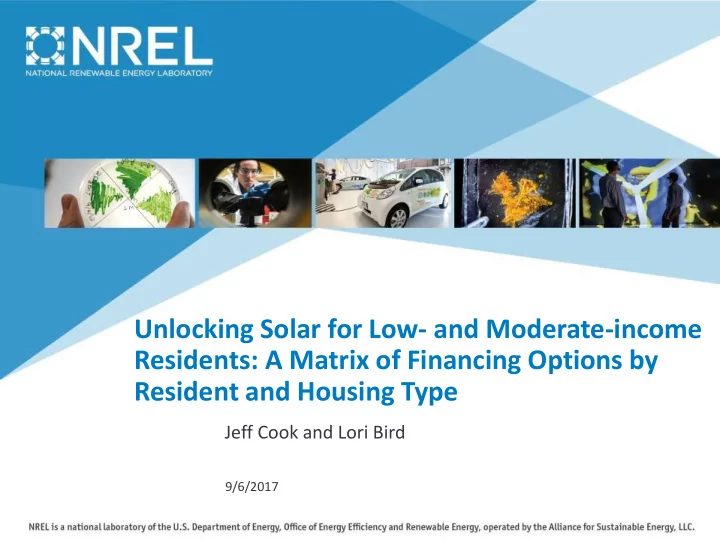

Unlocking Solar for Low- and Moderate-income Residents: A Matrix of Financing Options by Resident and Housing Type Jeff Cook and Lori Bird 9/6/2017
Project Objective • Objective o Develop a matrix of the top financing options for various housing types o Understand factors that impact effectiveness of financing approaches • Focus is on 3 common housing types: o Single-family Housing o Multi-family Housing (2+ units) o Manufactured Housing 2
Background • Key factors that influence the effectiveness of financing options for LMI customers: o Housing type o Renter vs homeowner o Federal housing subsidies (e.g., HUD) • We evaluated the applicability of 13 financing options for LMI residents • Financing options vary for: o LMI residents o Building owners/developers who can provide LMI solar access 3
Barriers and Considerations for Financing Options • Key barriers against LMI resident adoption of solar including: o Upfront costs or high cost of participation o Homeownership o Unsuitable home conditions • Financing options can have key tradeoffs that may be important to policymakers: • Cost to taxpayers • Upfront cost barrier • Deployment potential • LMI customer benefits 4
Financing Options 5
Top Financing Options by Housing Type
Federally-supported Housing Considerations • Federal subsidies can 6.0 influence the financing Housing Units (in millions) 5.0 options available to LMI 4.0 residents 3.0 • Subsidies can impact: 2.0 – Benefits to residents 1.0 – Approvals needed 0.0 • U.S. Department of Hud-assisted Units LIHTC-assisted Units Housing and Urban Development (HUD) Federally-supported Housing by Type • The Low Income Housing Tax Credit Housing (LIHTC) 7
Considerations for HUD-subsidized Housing • HUD Programs o Public Housing o Project-based Rental Assistance o Tenant-based Rental Assistance • HUD caps a resident’s rent and utilities to 30% of income o Any monetary benefit from solar that goes directly to a HUD-assisted resident factors into those payments as income • HUD must approve solar in public housing and project-based systems 8
Considerations for LIHTC Housing • LIHTC housing is NOT 40% regulated by HUD Percentage of All Reported 35% Projects (1995 -2015) – Implementing state 30% 25% agencies manage this 20% 15% program 10% 5% • HUD approval is not 0% 0-10 11-20 21-50 51-99 100+ required for solar Units Units Units Units Units – Additional research Number of Units may be needed to LIHTC Housing Size Characteristics from 1995 – determine solar 2015 requirements on a state-by-state basis 9
Single-family Housing
Single Family Homes (Detached) • Key Challenges o Homeownership o Building condition • Owners o On-site: available o Off-site: available • Renters o On-site: limited o Off-site: available 11
Top Financing Options for Owner-occupied Homes • LIHEAP/WAP – Colorado Rooftop Solar Program • Direct Cash Incentives – California Single-family Affordable Solar Housing • On-bill Financing – Ouachita Cooperative in Arkansas • Loans – Massachusetts’ Solar Loan Program • Third-party Leasing/ESA – PosiGen in Connecticut 12
Multi-family Housing
Multi-family Housing • Key Challenges o Landlord approval requirements o Building Metering – Mass metered – Individually metered • Landlord o On-site solar: available o Off-site solar: available • Resident o On-site solar: limited o Off-site solar: limited 14
Top Financing Options for Multi-family Housing Providers • Capital Refinancing – Anecdotal evidence • Third-party Leasing/ESA – Denver Housing Authority • LIHEAP/WAP • On-bill Financing • PACE – California has launched a PACE pilot 15
Manufactured Housing
Manufactured Housing • Key Challenges o Ownership structure – Home AND lot o Roof suitability • Landlord o On-site solar: available o Off-site solar: limited • Resident o On-site solar: limited o Off-site solar: available 17
Top Financing Options for Manufactured Housing Providers • LIHEAP/WAP – Eligibility uncertain for ground-mounted systems • Third-party Leasing/ESA • Direct Cash Incentives – Vermont McKnight Lane Project • Tax Incentives – Huntington Shorecliffs in California • PACE – Huntington Shorecliffs in California 18
Community Solar
Community Solar Financing Options for Residents • On-bill Financing – Green Valley Power Cooperative in Colorado • Loans – Massachusetts Solar Loan Program • Direct Cash Incentives – Rhode Island: $500 grant for LMI customer participation • Tax Incentives – Alpine Bank in Colorado • LIHEAP/WAP 20
Community Solar Financing Options for Developers • Direct Cash Incentives o Colorado LMI community solar demonstration projects • Production Incentives o Massachusetts SREC-II program • Tax Incentives o New Market Tax Credit • Crowdfunding • Net Metering 21
Summary Financing Matrix
23
Questions For further information related to the content of this presentation contact: Jeff Cook and Lori Bird Strategic Energy Analysis Center National Renewable Energy Laboratory Jeff.cook@nrel.gov and lori.bird@nrel.gov
Recommend
More recommend